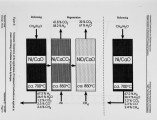| OCR Text |
Show Unmixed Combustion for Efficient Heat and American Flame Research Committee Mass Transfer in Chemical Processing Systems 1997 Fall International Symposium was that after the reactor reached steady state operation, the temperature controller on the electric furnace no longer turned on, indicating that the process was self sustaining. Average concentrations for carbon monoxide and total N O x were measured by continuous gas sampling with instrumental analyzers. As shown in Table 1, the C O levels varied from one condition to the next, but remained below 10 ppm. At the same time, N O x concentrations were at the detection limit of the instrument-roughly 0.03 ppm. The methane emissions shown in Table 1 are quite high relative to conventional combustion systems, however, formaldehyde was also measured, and found to be non-detectable in all cases, suggesting that undesirable products of incomplete combustion were not formed. A s will be shown later, Unmixed Combustion is quite capable of destroying hazardous organic compounds with great efficiency. A s to why such high levels of methane were observed in these tests, it is important to recognize that the reaction between methane and the copper oxide catalyst pellet is an internal diffusion limited process. This is supported by other data that have shown that as the temperature is increased methane emissions decrease. For example, at a constant fuel/air equivalence ratio of 0.617 methane dropped from 200 to 97 p p m as temperature was raised from 700 to 800 °C. Proper design of the catalyst and packed bed-for example, by replacing the pellets with a monolithic honeycomb support-can easily reduce these emissions. One reason for the effectiveness of Unmixed Combustion is the density with which oxygen can be stored in the solid phase. For the previous example the Unmixed Combustion catalyst consisted of 25.5 wt-percent C u O on alumina. If w e assume that the catalyst pellets have an apparent density of 1 g/cm3 and a packing density of 75 percent, then the density of oxygen in the packed bed will be 0.038 g/cm3. Not only is this about 140 times the density of oxygen in air at atmospheric pressure (making it equivalent to 2100 psia air pressure), the density, and hence the oxygen availability, does not change appreciably with temperature. The results of other tests are shown in Figures 3, 4 and 5. For Figure 3, both NOx and oxygen were measured continuously at the exit of the reactor illustrated in Figure 2. The reactor was operated continuously at a fuel/air equivalence ratio of 0.458, with an air flow of 3660 cmVmin and a methane flow of 2513 cmVmin. The air was turned on for 15 seconds each cycle followed by a 1 second pulse of methane. Throughout these tests the N O x concentration varied between 0.4 and 0.75 ppm, while the oxygen concentration oscillated between 3.25 and 13 percent. The fact that the oxygen concentration did not fall to zero is attributed to mixing in the gas sampling equipment. Figures 4 and 5 show how both oxygen and NOx are affected by the fuel/air equivalence ratio. These results are essentially an extension of the tests represented in Figure 3, however, the methane flow rate was varied and the reactor allowed to reach steady state before collecting data. The results show, as expected, that oxygen concentration declines and the N O x emissions increase as the fuel-air ratio approaches stoichiometric, reflecting both the increase in oxygen demand and the higher temperature of the reactor. Fairmont Hotel Chicago, Illinois September 21 -241997 Page 4 |























